Summary of the day: Western officials have suggested a possible “freeze” in the conflict lines, acknowledging that the latest US military aid might not enable Ukraine to recover all its lost territories. Meanwhile, there has been a surge in diplomatic activities involving Russia, Belarus, China, Iran, and North Korea, indicating a strengthening alliance against the West. On the ground in Ukraine, Russian forces have advanced northwest of Avdiivka and have made gains in the Kherson Oblast on the east bank. Amid these military movements, Ukraine’s allies continue to provide crucial military support, especially for air defenses, despite challenges such as the withdrawal of US-provided Abrams tanks due to the threat of Russian drone strikes.
What Can I Do To Help Ukraine? This is a question I receive all the time. We at Transform Ukraine are building longer-term housing for internally displaced Ukrainians. Visit Rebuild Ukraine for how you can assist in housing a Ukrainian family displaced by the war.
Beyond Ukraine – March Towards World War
In recent days, a series of over 10 bilateral high-level meetings among Russia, Belarus, China, Iran, and North Korea from April 22 to 26 has underscored a strengthening alliance against the West, with discussions of bolstering military ties and cooperation in intelligence. Defense ministers such as Russia’s Sergei Shoigu and China’s Dong Jun convened at the Shanghai Cooperation Organization meeting in Kazakhstan to enhance Russian-Chinese relations and foster Russian-Iranian military cooperation. Additionally, increased cooperative efforts between China and Iran were evident, notably with Iran participating for the first time as an SCO member. Parallel diplomatic and security talks involved Russian and Iranian deputy foreign ministers and security council secretaries, resulting in a memorandum of understanding between Russia and Iran. The frequency and visibility of these meetings highlight a unified strategy to consolidate military and political bonds in a unified front against Western influence.
During a meeting with U.S. Secretary of State Antony Blinken, Chinese officials blamed NATO for Russia’s invasion of Ukraine. Blinken countered by accusing China of aiding Russia’s war efforts by providing materials for weapons manufacturing and threatened action if such support continues. Meanwhile, a Chinese Foreign Ministry spokesperson shifted the blame to Western countries for supplying over 60% of Russia’s weapons components. This statement, stronger than China’s previous positions, aligns closer to Russia’s narrative, suggesting a tilt in China’s stance, potentially impacting future peace talks and international relations concerning the Ukraine crisis.
Russian Foreign Ministry spokesperson Maria Zakharova accused the US and NATO of threatening nuclear escalation, responding to concerns over Poland’s readiness to host NATO nuclear weapons as stated by Polish President Andrzej Duda on April 22. In contrast, NATO Secretary General Jens Stoltenberg clarified on April 23 that NATO has no plans to deploy additional nuclear weapons to any more NATO countries.
The Armenian Ambassador to the EU, Tigran Balayan, indicated that Armenia might block additional Russian state TV programs to counteract Russian information campaigns that challenge Armenia’s sovereignty. In a Moscow Times interview, Balayan noted that Russian media has been promoting negative perceptions of Armenia’s independence and its leadership. Although Russian broadcasts have limited influence on Armenian public opinion, they impact Russian-speaking viewers in Armenia.
Situation On The Land, Sea, and Air in Ukraine
US officials are discussing maintaining current conflict lines in Ukraine as recent military aid might be insufficient for Ukraine to reclaim all lost territories. Amid these talks, the latest US military aid is en route, aiming to stabilize the frontlines against ongoing Russian advances, particularly in areas like Avdiivka. The impact of this aid will be crucial as Ukraine prepares to defend against a potential Russian offensive expected in the summer. The success of Ukraine’s future military efforts depends significantly on continued Western support and strategic decisions by Ukraine and its allies.
The Ukrainian military has withdrawn US-supplied M1A1 Abrams tanks from the front line due to the high risk of detection and targeting by Russian drones. This tactical adjustment comes as the battlefield becomes highly observable with the use of numerous reconnaissance and attack drones by both sides. Protecting the relatively few Abrams tanks Ukraine has is a priority, given the vulnerability of armored vehicles without proper active defenses against drone and missile threats. Meanwhile, Russia is showcasing captured Western military equipment in Moscow and rewarding soldiers who destroy such assets, claiming the superiority of Russian military hardware.
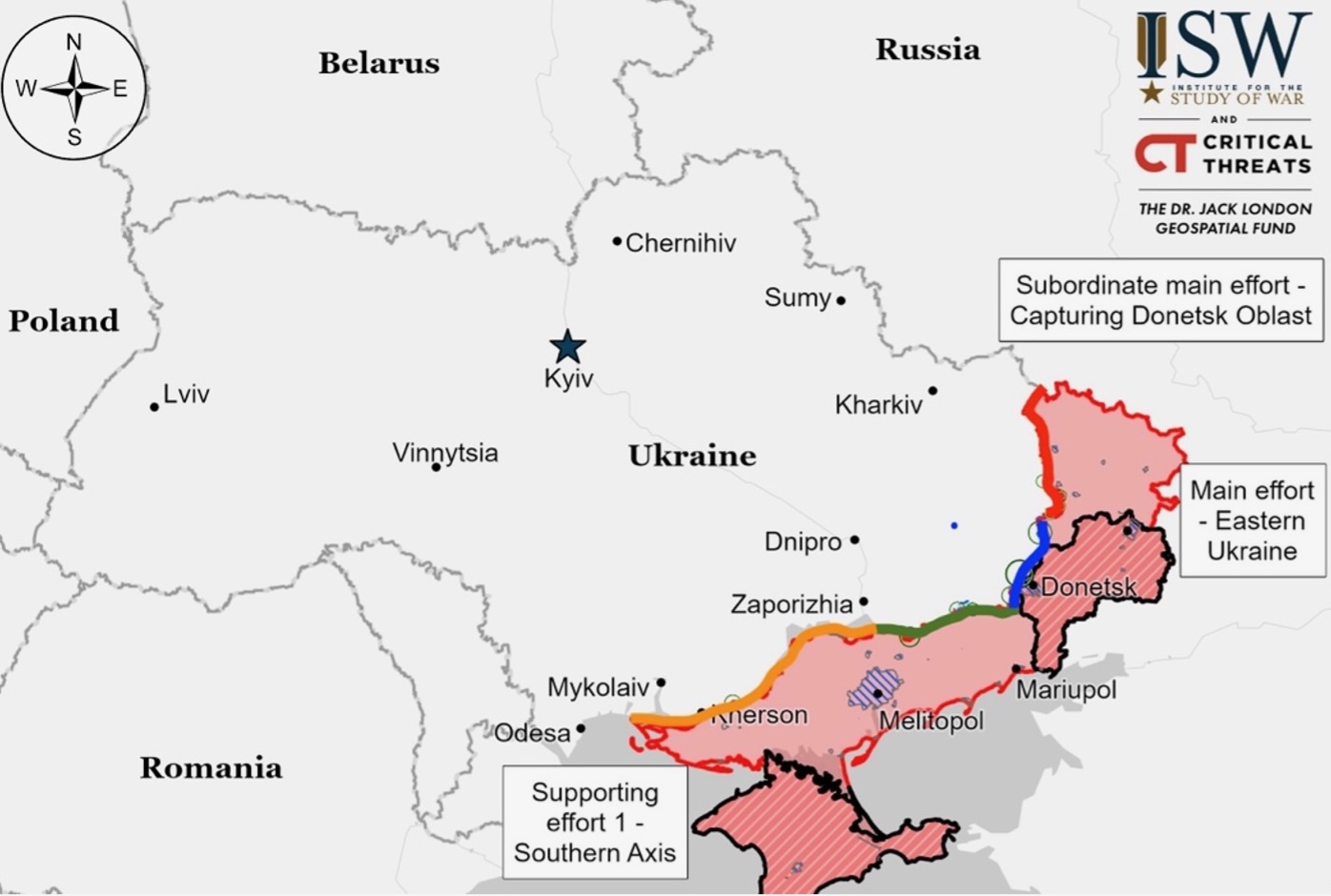
Luhansk Front – Initiative Russia
Donetsk Front – Initiative Russia
Zaporizhia Front – Initiative Russia
Kherson (Dnipro River) Front – Initiative None
There were ongoing positional battles along the Kupyansk-Svatove-Kreminna line in Ukraine, yet no significant changes to the front line were reported. Skirmishes took place in several locations around this line, including near Kyslivka, Berestove, Stelmakhivka, Druzhelyubivka, Makiivka, Terny, Zarichne, Torske, the Serebryanske forest, and Bilohorivka. Despite a Russian blogger’s claim of an advance near Terny and Yampolivka, no visual confirmation of such changes has been provided.
Fighting persisted in the Siversk region northeast of Bakhmut without any significant shifts in the front line. Clashes occurred to the east, south, and southeast of Siversk, specifically around Verkhnokamyanske, Mykolaivka, Vyimka, and Spirne.
Russian forces pressed their offensive near Chasiv Yar without altering the front line. Battles took place in various locations around Chasiv Yar, with Ukrainian forces noting Russian attempts to encircle the area and breach defenses, particularly east of the city. There is activity suggesting Russian preparation for a continued push, including regrouping and demining in the Bila Hora region.
Russian troops are intensifying efforts to encircle Chasiv Yar in Donetsk Oblast, located about 10 kilometers west of Bakhmut and 50 kilometers north of Avdiivka. According to Nazar Voloshyn, spokesperson for the Khortytsia Group of Forces, the strategic goal is to outflank Chasiv Yar through the villages of Bohdanivka and Ivanivske, facilitating further advances toward Kostiantynivka, Kramatorsk, and Sloviansk. Despite ongoing assaults, Russian forces have not made significant progress in the past week. The operation aims to secure the town by May 9, aligning with Russia’s Victory Day celebrations. Concurrently, up to 25,000 Russian troops are involved in the offensive, while the U.S. has passed an aid bill to bolster Ukraine’s defense, although concerns remain about its sufficiency to reclaim all lost territories.
Russian troops have made tactical gains around Avdiivka, with unconfirmed reports of progress in several nearby locations. Footage suggests minor advances in Solovyove and Semenivka. Russian milbloggers also report advances along the Ocheretyne-Hrodivka highway and around Novobakhmutivka and Novokalynove. While claims of Russian control over Semenivka persist, Ukrainian spokesperson Voloshyn says Ukrainian forces hold most of Ocheretyne and are defending against further advances. Despite some Russian reports of Ukrainian withdrawals, the situation remains contested, with ongoing clashes reported in multiple areas.
Russian forces persisted in their offensive operations west and southwest of Donetsk City without any verified changes to the front line. Claims by Russian military bloggers of advances near Krasnohorivka and a breakthrough at Paraskoviivka have not been visually confirmed. Skirmishes were reported around Krasnohorivka, Heorhiivka, Pobieda, Novomykhailivka, and Vodyane. There is footage of a Russian mechanized assault in Krasnohorivka, but the impact on the overall military situation remains unclear.
Ongoing positional battles were reported along the Donetsk-Zaporizhia Oblast border, specifically near Velyka Novosilka. Despite claims by a Russian military blogger of a 200-meter advance near Urozhaine, no visual confirmation is available. Clashes also occurred near Prechystivka and Staromayorske. Additionally, Russian forces are active near Vuhledar, southwest of Donetsk City.
Russian forces were reported to have made advances in western Zaporizhia Oblast, although no changes to the frontline were confirmed. Claims of movement northwest of Verbove remain unverified. Positional fighting persisted near Robotyne and northwest of Verbove. Additionally, reports indicate increased Ukrainian shelling and drone strikes against Russian positions in the area.
Russian forces made a minor advance in east Kherson Oblast, as evidenced by geolocated footage, although the move may not be recent. Positional engagements persisted near Krynky and the Antonivsky roadway bridge north of Oleshky.
Ukrainian Civilian Victims Of War
Since April 2022, Russian “double-tap” strikes have killed over 90 Ukrainian first responders and injured nearly 350 civilians, according to Timothy Hanway, acting U.S. envoy to the OSCE. These attacks, where a secondary strike targets first responders at the scene, are recognized as war crimes. Recent reports highlight an increase in these tactics, with significant casualties among rescue workers in cities like Odesa, Kharkiv, and Zaporizhzhia just in March and April 2024. This method has been previously used by Russia in conflicts in Syria and Chechnya.
The casualty count of Ukrainian civilians in the past 24 hours:
DEATHS: 2 INJURIES: 23
- Russian forces launched nearly 20 attacks on Nikopol District in Dnipropetrovsk Oblast, injuring three people. The strikes damaged 12 houses, multiple high-rise buildings, three utility buildings, and a stadium. Among the injured were a 42-year-old man, a 9-year-old boy, and an 18-year-old.
- Russian forces launched attacks on Kharkiv Oblast, injuring four civilians. The assaults, involving missiles, glide bombs, and drones, have been focused on destroying energy infrastructure and targeting civilians. In Shestakove, an S-300 missile struck an agricultural business, injuring a 42-year-old man. Additionally, a drone attack in the Bohodukhiv district hit a civilian car, wounding a family of three who were delivering humanitarian aid at the time. The victims included a 55-year-old woman, her 57-year-old husband, and their 19-year-old son.
- Russian forces targeted Bilopillia in Sumy Oblast, close to the Ukraine-Russia border, killing two women and injuring three others. The attack, lasting two hours, damaged a high-rise and several homes. Victims included women aged 77 and 69. Additionally, Russian troops struck industrial facilities in Sumy with guided aerial bombs; no casualties were reported there. First responders are currently active at the sites.
- The number of casualties from a Russian attack near Balakliia’s railway station in Kharkiv Oblast on April 25 has increased to 13. The strike damaged the station and a nearby passenger train, resulting in injuries to 11 people, including three railway workers. Victims, who were on the train at the time, sustained blast injuries and were hospitalized. Two additional civilian injuries were confirmed on April 26.
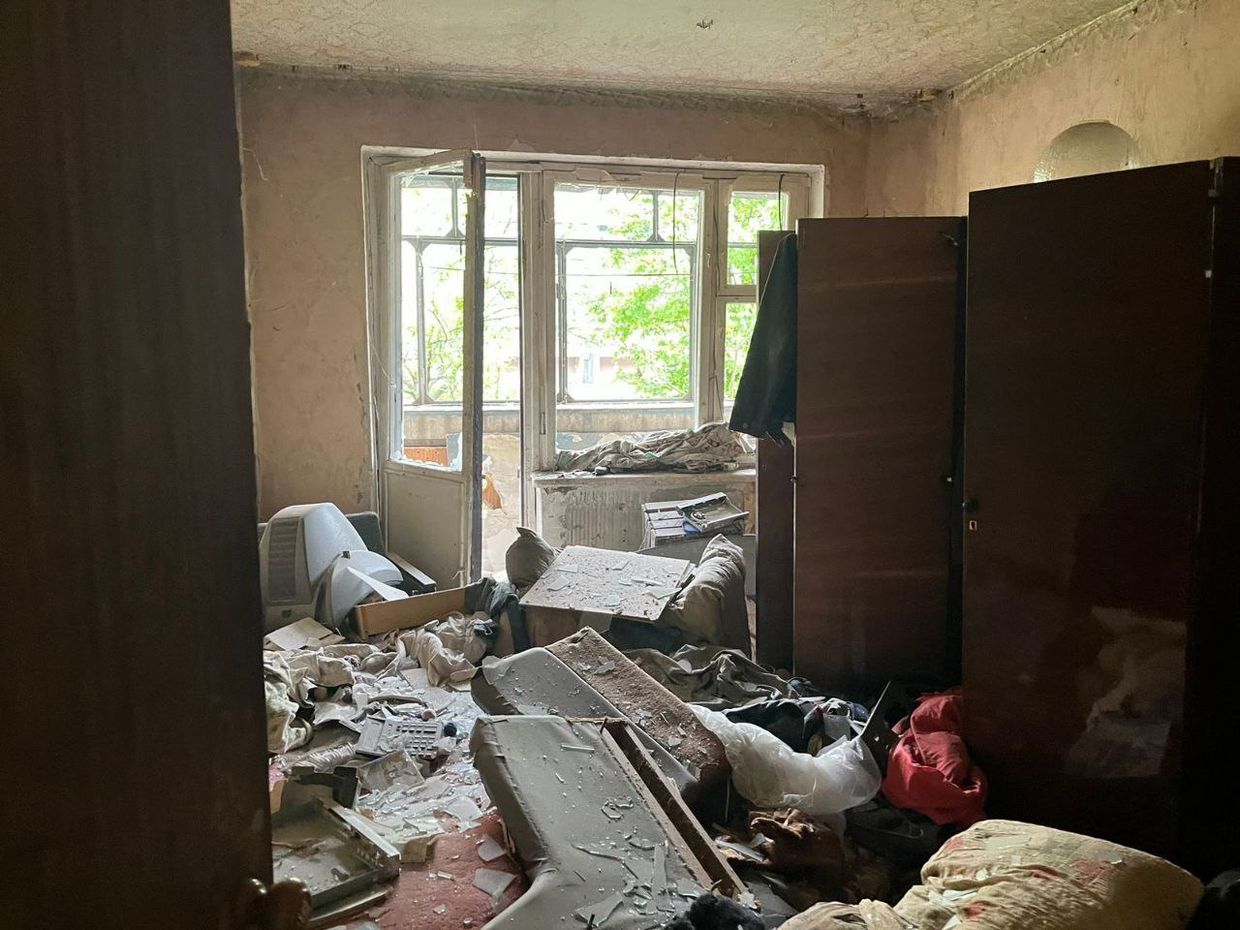 An apartment damaged by Russian shelling of Nikopol
An apartment damaged by Russian shelling of Nikopol
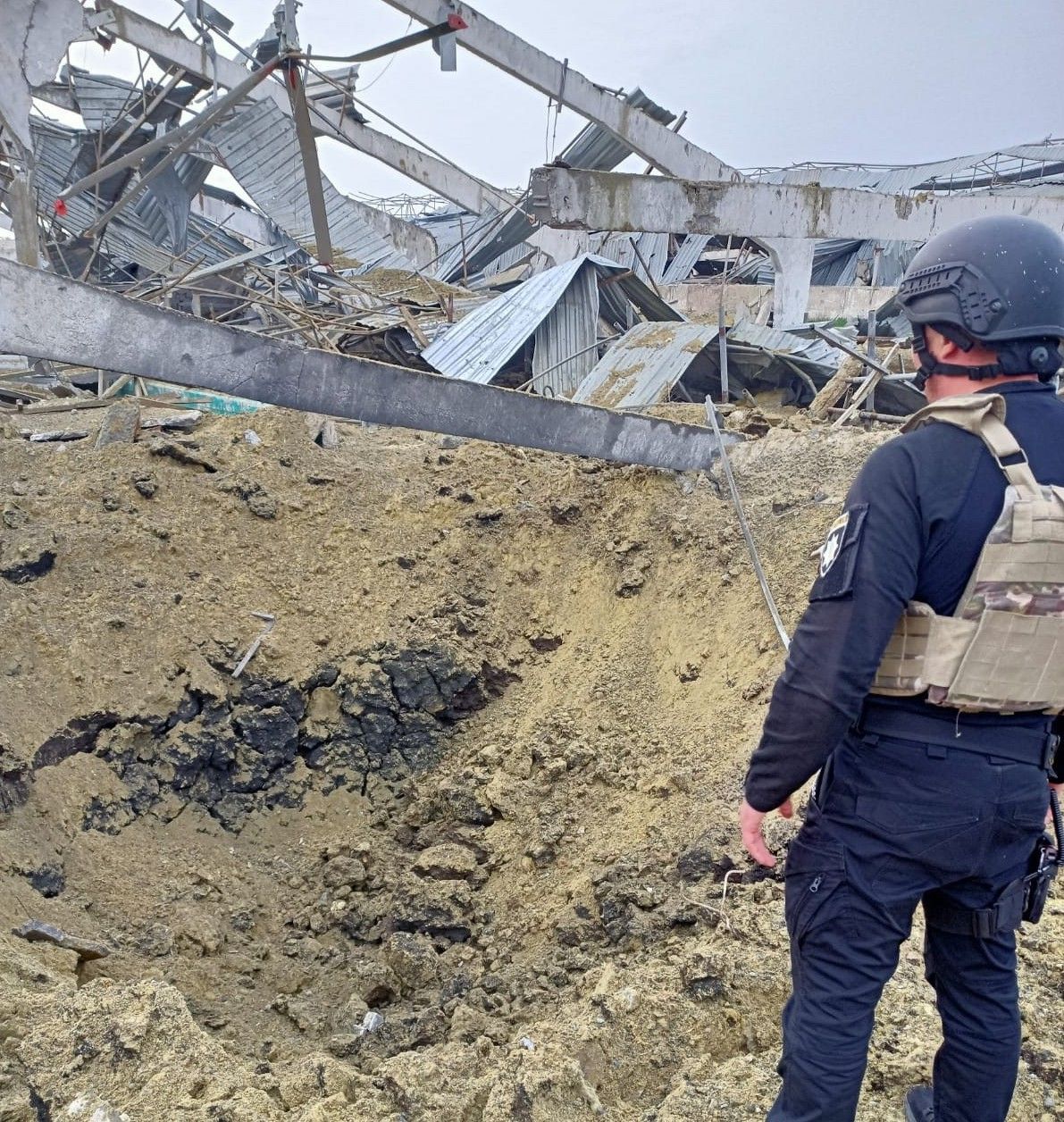 The aftermath of a Russian missile attack against an agricultural enterprise in Kharkiv Oblast
The aftermath of a Russian missile attack against an agricultural enterprise in Kharkiv Oblast
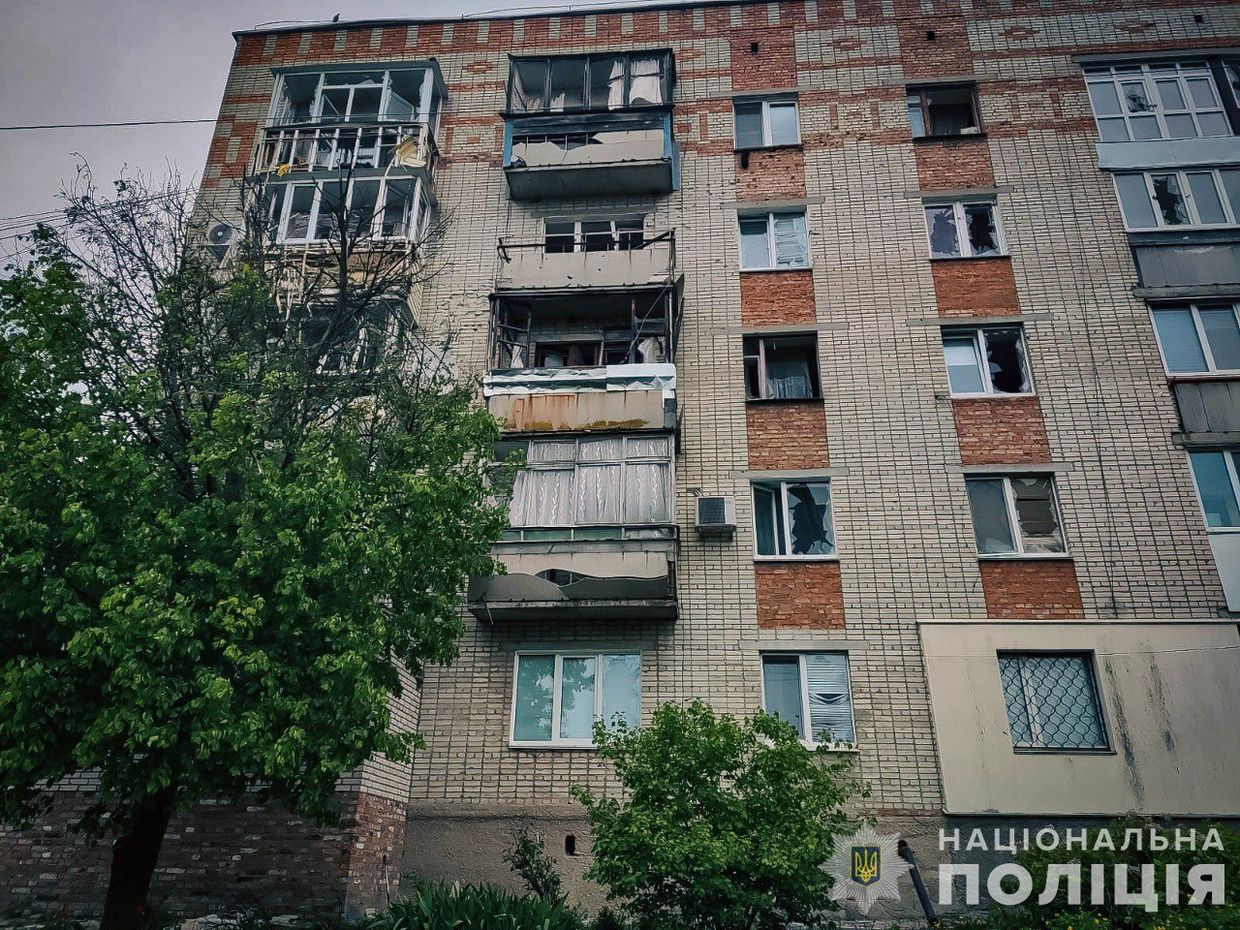 The aftermath of Russian attacks on Sumy Oblast
The aftermath of Russian attacks on Sumy Oblast
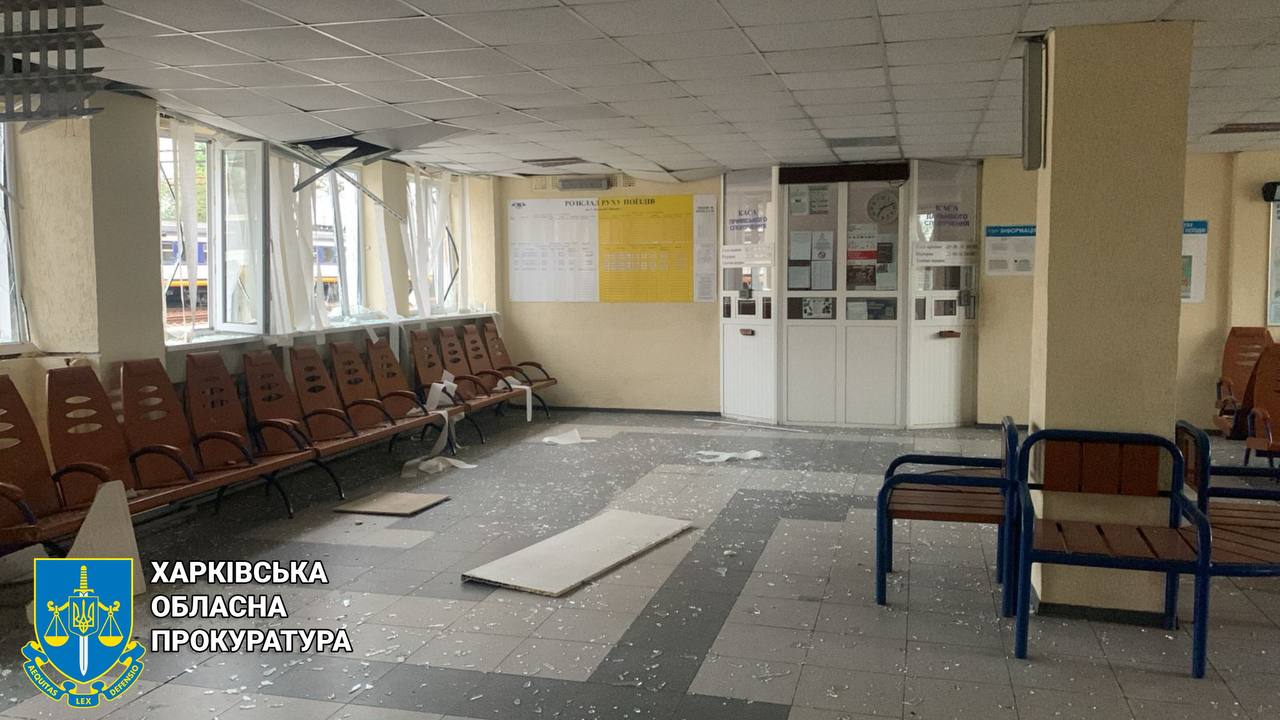 The aftermath of the Russian attack on the city of Balakliia
The aftermath of the Russian attack on the city of Balakliia
Ukraine News
Russian forces targeted Ukrainian railway and industrial sites, claiming to have hit a train carrying Western weapons in Donetsk Oblast and an industrial facility in Sumy City. Additionally, Ukrainian Air Force officials reported that Russia is employing Su-57 fighter jets to launch missiles from distances that evade Ukrainian air defenses. These aircraft are capable of firing Kh-69 cruise missiles.
Ukraine has repatriated the bodies of 140 soldiers who died fighting against Russia, according to the Coordination Headquarters for the Treatment of Prisoners of War. The fallen soldiers were identified, and their bodies will be handed over to their families for burial. This effort involved collaboration between various government and military agencies, including the Security Service of Ukraine, the Interior Ministry, the State Emergency Service, and the Armed Forces. The International Committee of the Red Cross also provided assistance. President Zelensky previously stated that around 31,000 Ukrainian soldiers have died in the conflict, emphasizing the significant loss.
On the anniversary of the Chornobyl disaster, Ukrainian President Volodymyr Zelensky highlighted the ongoing threat posed by Russia’s control over the Zaporizhzhia Nuclear Power Plant, Europe’s largest nuclear facility. Occupied by Russian forces since March 2022, the plant has faced disruptions due to attacks on Ukraine’s energy infrastructure. Zelensky emphasized the global responsibility to pressure Russia to release control of the plant and safeguard all nuclear sites in Ukraine. He paralleled the Chornobyl accident’s widespread impact, noting the universal threat of radiation, which does not respect borders or flags. The 1986 Chornobyl disaster, which spewed radioactive material across Europe and is considered the worst nuclear disaster in history, resulted in an estimated 4,000 deaths linked to radiation exposure over time. Zelensky commended the dedication of those who managed the Chornobyl crisis and those currently protecting lives amid ongoing threats.
Kyiv is urgently evacuating two hospitals, including a children’s facility, due to the risk of air strikes. The targeted hospitals are on Bohatyrska Street in the Obolon district. The evacuation follows a social media video that wrongly suggests the hospitals are harboring military personnel. The Kyiv authorities have refuted these claims, stating no military are present in the hospitals. The Security Service of Ukraine considers the video part of psychological operations benefiting Russia. Despite the lack of concrete evidence of an impending attack, Kyiv’s Mayor has initiated the evacuation to safeguard patients and hospital staff.
In central Ukraine, the Kvilinsky Garden flower farm in Myrhorod has ceased operations following the death of its owner, Jan Kvilinsky, who was also a Special Operations Forces operative. The farm, known for its roses, announced on Facebook that it “no longer grows or sells flowers” after Kvilinsky died in combat in the Donetsk region on January 23. He had joined the army on September 26, 2023, and was part of the 3rd Separate Special Purpose Regiment. Kvilinsky was buried in the Alley of Heroes in Myrhorod.
Ukraine’s Allies
The U.S. has committed $6 billion in military aid to Ukraine, as announced by Secretary of Defense Lloyd Austin, focusing on air defenses with equipment like Patriot and NASAMS air defense system interceptors, as well as HIMARS munitions. This package, the largest to date, also funds anti-drone systems, significant artillery ammunition, and air-to-ground weaponry, plus munitions for laser-guided rockets, HIMARS launcher rockets, various radars, and artillery rounds. It marks a shift from immediate aid to contracts for U.S. defense companies to produce new supplies, expected to take several years to reach Ukraine. A concurrent $1 billion aid package from current U.S. stocks includes ammunition and armored vehicles, following a new foreign aid bill signed by President Biden that allocates $60.84 billion for Ukraine. Spain also plans to send Patriot missiles, complementing Ukrainian President Zelensky’s emphasis on the need for long-range weaponry and air defense systems, citing the heavy use of guided bombs by Russia. Despite recent setbacks and the acknowledgment by Austin of the Patriot system’s limitations in combat, Zelensky remains confident in Ukraine’s ability to stabilize and advance on the front lines amidst ongoing Russian attacks on Ukrainian infrastructure.
The Pentagon has started delivering a new aid package of weapons and ammunition to Ukraine, according to Pentagon spokesman Brigadier General Patrick Ryder. While some items may take longer to arrive, efforts are being made to expedite essential supplies like artillery ammunition. Concurrently, concerns have arisen over the potential deployment of up to 60 U.S. military advisers to Kyiv to assist with weapons transfers, stirring fears of an escalation similar to the Vietnam War. However, Ryder emphasized that these advisers would operate in non-combat roles from the U.S. embassy, focusing on logistics and oversight.
Prime Minister Denys Shmyhal announced that Ukraine secured $12 billion in external financing this year to tackle the budget deficit, a crucial step in addressing economic challenges. Shmyhal highlighted significant contributions, including 1.5 billion euros from the EU and nearly $8 billion from the recently passed U.S. aid package. These funds are vital for supporting medical services, healthcare worker and teacher salaries, and social programs. Shmyhal expressed gratitude to allies and partners for their support.
Belgium is set to contribute 200 million euros to a German-led air defense initiative for Ukraine and will supply additional rockets from its military stocks to help Ukraine counter increased Russian attacks, though the types of rockets remain unspecified by Defense Minister Ludivine Dedonder. Belgium also calls for Russia to halt its invasion and seeks a diplomatic solution. Concurrently, Belgium is working to accelerate the delivery of F-16 fighter jets to Ukraine, possibly by the end of this year, in an effort coordinated with the U.S.-led F-16 training coalition. This plan aligns with the U.S. pledge to send more than a squadron of F-16s to Ukraine, complete with trained personnel.
Spain will supply Ukraine with Patriot anti-aircraft missiles, with delivery preparations to begin within four days, as confirmed by Spanish Defense Minister Margarita Robles at the Ramstein-format summit. The exact number to be sent is unspecified, given Spain’s limited reserves. Additionally, Spain is committing other military equipment, including machine guns, vehicles, artillery howitzers, shells, anti-drone equipment, and Leopard tanks.
Canada will donate $2.2 million to Ukraine’s domestic drone production and $9.5 million to a Czech-led ammunition initiative, as announced by Canadian Defense Minister Bill Blair. These contributions are part of a wider military assistance package from Canada, including an increase in the total contribution to the ammunition initiative to $38.7 million. Additionally, Canada will provide 100 more drones, bringing the total to 900, and begin sending 10 of 50 armored combat support vehicles this summer. The commitments also include the delivery of 10 multirole boats by July. This support is backed by Canada’s 2024 budget, pledging $1.16 billion to Ukraine’s defense over the next five years. Canada has already provided over $10 billion in assistance to Ukraine since the start of the conflict.
In her inaugural foreign visit, Latvian Foreign Minister Baiba Braze met with Ukrainian counterpart Dmytro Kuleba in Kyiv, reflecting Latvia’s firm commitment to supporting Ukraine. The ministers honored those lost at Kyiv’s Wall of Remembrance, a symbol of the two nations’ camaraderie. This visit underscores Latvia’s recent 392-million-euro contribution and its role in a drone coalition aiding Ukraine. Both nations are intensifying their collaborative efforts in drone production, reinforcing their defense strategies. Additionally, Latvia’s provision of a significant generator responds to Ukraine’s energy demands amidst ongoing conflict, and consolidates the support demonstrated through Latvia’s substantial military aid and a 10-year bilateral security agreement. Latvia’s contribution to Ukraine’s cause, significantly through the drone coalition co-led with the U.K., showcases its steadfast support.
A 20-year-old U.K. man, Dylan Earl, with reported ties to the Wagner Group, faces charges for planning arson and for his role as a recruited Russian spy. This is the first use of the U.K.’s 2023 National Security Act, targeting hostile foreign actions. Earl’s charges include plotting an attack on London businesses linked to Ukraine, fraud, and attempting to recruit for foreign intelligence. Four other men are also charged in the case. Their trial date at London’s Central Criminal Court is pending.
Life in Russian-Occupied Ukraine
Maria Zakharova, the Spokesperson for the Russian Ministry of Foreign Affairs, suggested that Ukraine poses a threat to the security of the Russian-occupied Zaporizhzhia Nuclear Power Plant (ZNPP), seemingly deflecting from Russia’s own actions. Reports indicate that Russian forces have compromised the safety of the ZNPP by storing military equipment such as ammunition, armored personnel carriers, and anti-aircraft guns on the premises.
The Organization for Security and Cooperation in Europe (OSCE) reported that Russia has detained thousands of Ukrainian civilians under harsh conditions, subjecting them to torture, extrajudicial killings, and other forms of cruel treatment. The OSCE’s statement, endorsed by 45 member states, highlighted systematic abuses including sexual violence and punishment for cultural expressions. It stressed that these actions, including the lack of investigation into the killings, violate international human rights laws and could constitute war crimes and crimes against humanity.
Russian occupation authorities are intensifying their efforts to Russify Ukrainian youth in occupied territories through forced deportations and cultural suppression. Recent reports highlight the transfer of four disabled Ukrainians to a new center in Penza Oblast, with no plans discussed for their return. Additionally, in occupied Crimea, libraries have been directed to remove materials with pro-Ukraine content, details of the Holodomor genocide, and information on Crimean Tatar activities. Further, the militarization of Ukrainian children continues, with plans to teach drone operation in schools starting September 2024.
Russian occupation authorities in Ukraine are working to rebuild logistics and mining infrastructure amidst labor shortages. The head of the Kherson Oblast occupation government announced plans to reconstruct the Askania Nova-Chaplynka highway, a key route to occupied Crimea, by summer 2024. Meanwhile, in occupied Luhansk Oblast, audits are underway to assess the profitability of 33 remaining mines, with previous evaluations deeming nearly 100 out of 114 mines unprofitable. Additionally, about 60 percent of mine workers have been coerced into serving in the Russian military.
Russia News
Ukraine’s military intelligence agency reported that a Russian Ka-32 helicopter was destroyed at Moscow’s Ostafyevo airfield. The operation was attributed to Ukrainian forces, known for targeting military assets and industrial sites inside Russia. The destroyed helicopter was utilized by the Moscow aviation center to support Russian military operations. The airfield, jointly operated by Russia’s Defense Ministry and Gazpromavia, suffered a fire, as shown in shared video footage. Ukraine has recently intensified strikes against military targets in Russia, including airfields like Yeysk and Morozovsk, resulting in significant losses for the Russian military.
Ukrainian military intelligence reportedly conducted a cyberattack on April 26 against Russia’s United Russia party’s online platforms, as part of its Victory Day campaign. Despite the attack, United Russia maintained that their critical digital infrastructure was operational. The attack rendered the party’s platforms “partially inaccessible.”
The Kremlin plans to display captured Ukrainian and Western military equipment, including German tanks and other hardware, at an exhibition in Moscow’s Victory Park on May 9, as part of Russia’s Victory Day celebrations. The exhibit, opening May 1, will feature over 30 items from twelve countries, including vehicles, small arms, and ideological materials, highlighting Russia’s claims of success against Ukrainian forces and their Western allies. Victory Park has been a key site for Russian patriotic displays since its inauguration in 1995 and is managed by Moscow’s Ministry of Culture. The display is intended to reinforce Russian military achievements in Ukraine.
Russia’s Sberbank reported a first-quarter net profit of $4.32 billion, up 11.3% from last year, despite Western sanctions. The bank also recorded a $16.3 billion annual profit in 2023, significantly higher than previous years. This financial rebound comes after a sharp profit decline following the 2022 sanctions due to Russia’s invasion of Ukraine. Additionally, the bank announced a dividend payout of $8.04 billion, with majority ownership by the Russian state. Economic measures like subsidized mortgages have boosted the banking sector, leading to a 35% increase in mortgage lending in 2023. However, this growth is driving up inflation, which poses long-term economic challenges.
Russian Mobilization and Defense Industrial Base
Radio Free Europe/Radio Liberty reported that Samara Oblast is forming a new volunteer motorized rifle battalion named “Batyr,” aiming to recruit 400 personnel primarily from Tatarstan in May-June 2024. Recruits signing up for the “Batyr” battalion will receive payments totaling approximately 600,000 rubles ($6500) from Samara Oblast and the Russian Ministry of Defense, with additional support from the Tatarstan government.
Russian military personnel, particularly those recruited from penal colonies, have committed significant crimes in Russia after returning from Ukraine. According to a report by the Russian opposition outlet Verstka on April 25, these individuals have been responsible for the deaths of 107 people, including 76 murders across 55 incidents, and have injured another 100 people through various violent acts. Most offenders were identified as former penal colony recruits, including those from the Wagner Group.
The Telegram channel of the Russian 1430th Motorized Rifle Regiment shared footage showing Russian forces using ropes and hooks to retrieve downed drones from minefields. This technique is used to minimize personnel losses. The regiment is currently active near Urozhaine in the Donetsk-Zaporizhia border area.
Russian Narratives and Propaganda
Russian officials are seeking to label opposition to the war in Ukraine as extremist, potentially criminalizing anti-war views by associating them with a non-existent “Anti-Russian Separatist Movement.” This move could broadly target anti-war sentiments and activities, allowing for the prosecution of those opposing Russia’s actions in Ukraine or advocating for the rights of ethnic minorities and conscripted soldiers. The effort appears aimed at framing any dissent against the war as an attack on Russian unity and territory.
Russian officials are attempting to shift blame for their military’s use of chemical weapons in Ukraine by accusing the US of supporting Ukrainian forces’ alleged use of such weapons. This claim was made by Russia’s representative to the Organization for the Prohibition of Chemical Weapons. Meanwhile, an investigation by The Telegraph has revealed that Russian forces are systematically using banned chemical substances, including daily attacks with chemical agents along the frontline. Notably, Russia’s 810th Naval Infantry Brigade admitted in a deleted post to using CS gas, a prohibited riot control agent, against Ukrainian positions in Kherson Oblast in December 2023.
Source Materials
Institute for the Study of War – understandingwar.org
The Kyiv Independent – kyivindependent.com
Kyiv Post – kyivpost.com
